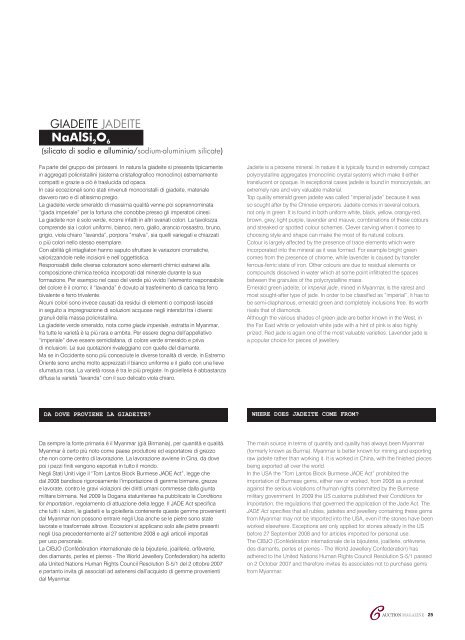You also want an ePaper? Increase the reach of your titles
YUMPU automatically turns print PDFs into web optimized ePapers that Google loves.
Fa parte del gruppo dei piròsseni. In natura la giadeite si presenta tipicamente<br />
in aggregati policristallini (sistema cristallografico monoclino) estremamente<br />
<strong>com</strong>patti e grazie a ciò è traslucida od opaca.<br />
In casi eccezionali sono stati rinvenuti monocristalli di giadeite, materiale<br />
davvero raro e di altissimo pregio.<br />
La giadeite verde smeraldo di massima qualità venne poi soprannominata<br />
“giada imperiale” per la fortuna che conobbe presso gli imperatori cinesi.<br />
La giadeite non è solo verde, ricorre infatti in altri svariati colori. La tavolozza<br />
<strong>com</strong>prende sia i colori uniformi, bianco, nero, giallo, arancio rossastro, bruno,<br />
grigio, viola chiaro “lavanda”, porpora “malva”, sia quelli variegati e chiazzati<br />
o più colori nello stesso esemplare.<br />
Con abilità gli intagliatori hanno saputo sfruttare le variazioni cromatiche,<br />
valorizzandole nelle incisioni e nell’oggettistica.<br />
Responsabili delle diverse colorazioni sono elementi chimici estranei alla<br />
<strong>com</strong>posizione chimica teorica incorporati dal minerale durante la sua<br />
formazione. Per esempio nel caso del verde più vivido l’elemento responsabile<br />
del colore è il cromo; il “lavanda” è dovuto al trasferimento di carica tra ferro<br />
bivalente e ferro trivalente.<br />
Alcuni colori sono invece causati da residui di elementi o <strong>com</strong>posti lasciati<br />
in seguito a impregnazione di soluzioni acquose negli interstizi tra i diversi<br />
granuli della massa policristallina.<br />
La giadeite verde smeraldo, nota <strong>com</strong>e giada imperiale, estratta in Myanmar,<br />
fra tutte le varietà è la più rara e ambita. Per essere degna dell’appellativo<br />
“imperiale” deve essere semidiafana, di colore verde smeraldo e priva<br />
di inclusioni. Le sue quotazioni rivaleggiano con quelle del diamante.<br />
Ma se in Occidente sono più conosciute le diverse tonalità di verde, in Estremo<br />
Oriente sono anche molto apprezzati il bianco uniforme e il giallo con una lieve<br />
sfumatura rosa. La varietà rossa è tra le più pregiate. In gioielleria è abbastanza<br />
diffusa la varietà “lavanda” con il suo delicato viola chiaro.<br />
Jadeite is a piroxene mineral. In nature it is typically found in extremely <strong>com</strong>pact<br />
polycrystalline aggregates (monoclinic crystal system) which make it either<br />
translucent or opaque. In exceptional cases jadeite is found in monocrystals, an<br />
extremely rare and very valuable material.<br />
Top quality emerald green jadeite was called “imperial jade” because it was<br />
so sought after by the Chinese emperors. Jadeite <strong>com</strong>es in several colours,<br />
not only in green. It is found in both uniform white, black, yellow, orangy-red,<br />
brown, grey, light purple, lavender and mauve, <strong>com</strong>binations of these colours<br />
and streaked or spotted colour schemes. Clever carving when it <strong>com</strong>es to<br />
choosing style and shape can make the most of its natural colours.<br />
Colour is largely affected by the presence of trace elements which were<br />
incorporated into the mineral as it was formed. For example bright green<br />
<strong>com</strong>es from the presence of chrome, while lavender is caused by transfer<br />
ferrous-ferric state of iron. Other colours are due to residual elements or<br />
<strong>com</strong>pounds dissolved in water which at some point infiltrated the spaces<br />
between the granules of the polycrystalline mass.<br />
Emerald green jadeite, or imperial jade, mined in Myanmar, is the rarest and<br />
most sought-after type of jade. In order to be classified as “imperial”, it has to<br />
be semi-diaphanous, emerald green and <strong>com</strong>pletely inclusions free. Its worth<br />
rivals that of diamonds.<br />
Although the various shades of green jade are better known in the West, in<br />
the Far East white or yellowish white jade with a hint of pink is also highly<br />
prized. Red jade is again one of the most valuable varieties. Lavender jade is<br />
a popular choice for pieces of jewellery.<br />
DA Dove proviene lA giADeite? WHere DoeS JADeite CoMe FroM?<br />
Da sempre la fonte primaria è il Myanmar (già Birmania), per quantità e qualità.<br />
Myanmar è certo più noto <strong>com</strong>e paese produttore ed esportatore di grezzo<br />
che non <strong>com</strong>e centro di lavorazione. La lavorazione avviene in Cina, da dove<br />
poi i pezzi finiti vengono esportati in tutto il mondo.<br />
Negli Stati Uniti vige il “Tom Lantos Block Burmese JADE Act”, legge che<br />
dal 2008 bandisce rigorosamente l’importazione di gemme birmane, grezze<br />
e lavorate, contro le gravi violazioni dei diritti umani <strong>com</strong>messe dalla giunta<br />
militare birmana. Nel 2009 la Dogana statunitense ha pubblicato le Conditions<br />
for Importation, regolamento di attuazione della legge. Il JADE Act specifica<br />
che tutti i rubini, le giadeiti e la gioielleria contenente queste gemme provenienti<br />
dal Myanmar non possono entrare negli Usa anche se le pietre sono state<br />
lavorate e trasformate altrove. Eccezioni si applicano solo alle pietre presenti<br />
negli Usa precedentemente al 27 settembre 2008 e agli articoli importati<br />
per uso personale.<br />
La CIBJO (Confédération internationale de la bijouterie, joaillerie, orfèvrerie,<br />
des diamants, perles et pierres - The World Jewellery Confederation) ha aderito<br />
alla United Nations Human Rights Council Resolution S-5/1 del 2 ottobre 2007<br />
e pertanto invita gli associati ad astenersi dall’acquisto di gemme provenienti<br />
dal Myanmar.<br />
The main source in terms of quantity and quality has always been Myanmar<br />
(formerly known as Burma). Myanmar is better known for mining and exporting<br />
raw jadeite rather than working it. It is worked in China, with the finished pieces<br />
being exported all over the world.<br />
In the USA the “Tom Lantos Block Burmese JADE Act” prohibited the<br />
importation of Burmese gems, either raw or worked, from 2008 as a protest<br />
against the serious violations of human rights <strong>com</strong>mitted by the Burmese<br />
military government. In 2009 the US customs published their Conditions for<br />
Importation, the regulations that governed the application of the Jade Act. The<br />
JADE Act specifies that all rubies, jadeites and jewellery containing these gems<br />
from Myanmar may not be imported into the USA, even if the stones have been<br />
worked elsewhere. Exceptions are only applied for stones already in the US<br />
before 27 September 2008 and for articles imported for personal use.<br />
The CIBJO (Confédération internationale de la bijouterie, joaillerie, orfèvrerie,<br />
des diamants, perles et pierres - The World Jewellery Confederation) has<br />
adhered to the United Nations Human Rights Council Resolution S-5/1 passed<br />
on 2 October 2007 and therefore invites its associates not to purchase gems<br />
from Myanmar.<br />
25




